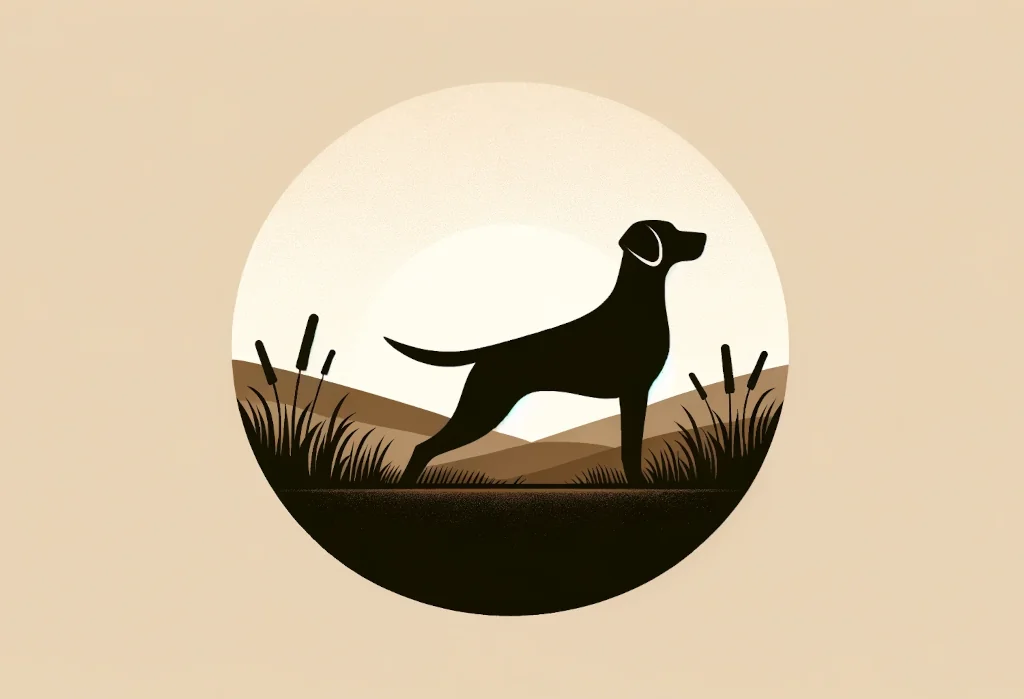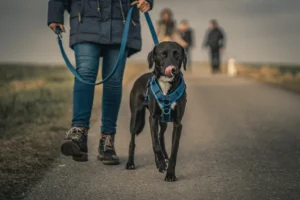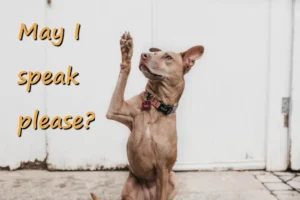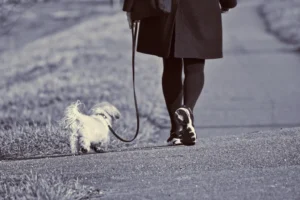When your canine companion decides they’re more interested in the scent on the ground than your stern call to halt, you know the struggle is real. It’s like trying to pause a movie with a remote that’s out of batteries—frustrating and futile.
In this blog post, you’ll learn the ropes of teaching your dog the critical command ‘Woah’ or ‘Stop’, an essential skill for safe and successful hunting adventures.
Key takeaways:
- Start ‘Woah’ or ‘Stop’ training in a quiet, distraction-free zone; use a consistent command paired with leash restraint, and reward immediate compliance.
- Reinforce the stop command through regular, positive drills, and gradually introduce hunting-like distractions to build an instinctual response.
- Keep training sessions short and diverse, using praise or play as incentives, to maintain your dog’s attention and strengthen their stop command obedience.
Why Is the ‘Woah’ or ‘Stop’ Command So Important for Hunting Dogs?
When it comes to training hunting dogs, the command to ‘Woah’ or ‘Stop’ is a game-changer.
Picture yourself out in the field, eyes trained on your dog, and the moment comes when you need them to freeze. In hunting scenarios, being able to control your dog with a reliable stop command is crucial. It isn’t just about obedience – it’s a matter of safety for both you and your dog.
A hunting dog that bolts or ignores commands could ruin the hunt or worse, put itself in danger. Whether it’s avoiding a potentially harmful situation, such as a busy road or hazardous terrain, or preventing the dog from scaring prey before the right moment, the ‘Woah’ command helps ensure that both the dog and hunter can work together safely and effectively. It cultivates a respectful partnership, with the dog understanding its role and the hunter guiding the action.
That ability to pause the excitement with a single word is what turns a good hunting trip into a great one.
How Do I Get Started with ‘Woah’ Training?
Embarking on ‘Woah’ training might seem daunting, but it’s like any journey – best started with a single step. First things first, choose a quiet and controlled environment free of distractions. Your backyard or a secluded park can be the perfect starting ground. Consistency is key, so pick a command – ‘Woah’, ‘Stop’, or any other distinctive word – and stick to it.
Gear up with a stash of treats or toys to reward and motivate your dog. They’ll need to associate the command with positive outcomes. Begin with the fundamentals. Have your dog on a lead and walk together. Come to a stop, use your chosen command, and gently enforce it by restricting their movement with the leash. If they stay still, even just for a second, it’s time for praise and a reward.
It’s all about baby steps. Don’t rush it, and don’t expect your pup to master it overnight. This is a gradual process where patience wins the race.
What’s the Best Way to Reinforce the ‘Stop’ Command?
Alright, you’ve introduced your dog to the ‘Woah’ command. How do you drill it into their instinct? The name of the game is reinforcement, and it’s simple to play if you’ve got the right moves.
Positive reinforcement should be your go-to. This means lots of praise, treats, or a favorite toy when your dog successfully follows the command. Make ‘Woah’ the best word they’ve ever heard. Reinforcement also comes with repetition. Practicing the command regularly ensures that it sticks.
Let’s talk timing. It’s about as essential as seasoning is to a chef. Issue the command just before you anticipate the moment you’ll need your dog to stop. This punctuality teaches them to be attentive. Consistency is just as important in your training sessions. If ‘Woah’ means stop now, it means stop always, in every session and in every scenario.
Now, for the unique insight: during training, introduce distractions gradually, which resemble a hunting environment. Start with a dummy bird or scents. This sets a real-world foundation, and your dog eventually experiences the full spectrum of temptation yet understands that ‘Woah’ means a non-negotiable stop.
For those who are comfortable using them, training tools like check cords or e-collars can be valuable. A check cord gives you control over distance while still enforcing the stop command remotely. And when properly used, an e-collar can provide a cue to your dog when they’re too far for a voice command to be effective. Always consult a professional trainer before using an e-collar to ensure safe and ethical training practices.
Remember, training your dog requires mutual respect and understanding. Your dog wants to please you, so guide them with a firm but gentle hand, and you’ll both enjoy the fruits of your labor out in the field.
How Can You Keep Your Dog Focused During Training?
Keeping your dog’s attention during training isn’t just helpful; it’s crucial. Here’s how to ensure your pooch stays focused on the task at hand when teaching commands like “Woah” or “Stop,” particularly useful for hunting dogs who need to be sharp and responsive.
Short and Sweet Sessions
– Keep training sessions brief. Dogs, much like humans, can only concentrate for so long before their minds start to wander. Aim for a span of 5-10 minutes to start with, especially for young pups, and gradually increase as your dog’s attention span grows.
Mix It Up
– Switch up your routine. Everyone gets bored doing the same thing over and over, and dogs are no different. Try practicing in different locations to keep the setting fresh and your dog engaged. A change of scenery can work wonders for focus.
Playful Learning
– Use play as a teaching tool. Integrating play into training sessions isn’t just fun; it’s effective. Instigate a game of tug-of-war or fetch right after practice. Your dog will start to connect following commands with the joy of playing, making them more eager to participate.
Engaging Rewards
– Stay unpredictable with rewards. Mix up the types of treats and rewards you give for correct responses. Sometimes give a small treat, other times lavish praise or a favorite toy. This variety can keep your dog guessing and attentive, hoping for that next great reward.
A unique tip? Consider your dog’s breed and instincts when maintaining focus. A hunting dog, for instance, might be more engaged if you use training aids that mimic the experience of hunting, such as scent trails or dummy game. Creating a real-world connection with the task can seriously ramp up their enthusiasm and concentration.
Can You Teach an Old Dog the ‘Woah’ Command?
You’ve probably heard the saying, “You can’t teach an old dog new tricks.” Well, guess what? That’s a myth. Older dogs can learn commands like “Woah” with the right approach. It requires patience and an understanding of your seasoned companion’s needs.
Adjust Expectations
– Go at their pace. Older dogs may not pick up on new commands as quickly as young whippersnappers. It’s okay. Allow for a more gradual learning curve and celebrate the small victories along the way.
Sensitivity Matters
– Be considerate of physical limitations. An older dog might have joint issues or may tire more easily. Be mindful of this during training and adjust accordingly. Keep sessions even shorter for seniors and never push past the point of discomfort.
Mental Stimulation is Key
– Provide plenty of mental stimulation, but without the intensity of physical demands. Learning “Woah” is as much a mental exercise as a physical one. Encourage your old pal by providing consistent, gentle guidance and plenty of encouragement.
Repeat and Reinforce
– Repetition is your friend. It might take a few more repetitions for an older dog to grasp the “Woah” command, but consistency will pay off. Always reinforce the command with the same word and gesture to avoid confusion.
Here’s something special for older dogs: tailor the training environment to be as comfortable and distraction-free as possible. A quiet, familiar place with little to no foot traffic can help your dog concentrate on your instructions without the added stress of a new or chaotic environment.
Remember, teaching your dog “Woah” is more than a trick; it’s a safety command and especially crucial for hunting dogs. Older dogs might be set in their ways, but with tenderness, patience, and a bit of creativity, they can certainly learn new, important commands.
In the end, it’s not the age that defines a dog’s ability to learn; it’s the bond and the mutual understanding between you and your four-legged friend that truly makes the difference. Keep things light, patient, and persistent, and you’ll be amazed at what your old dog can still learn.
Alex, a passionate animal lover, has experience in training and understanding animal behavior. As a proud pet parent to two dogs and three cats, he founded AnimalReport.net to share insights from animal experts and expand his knowledge of the animal kingdom.










